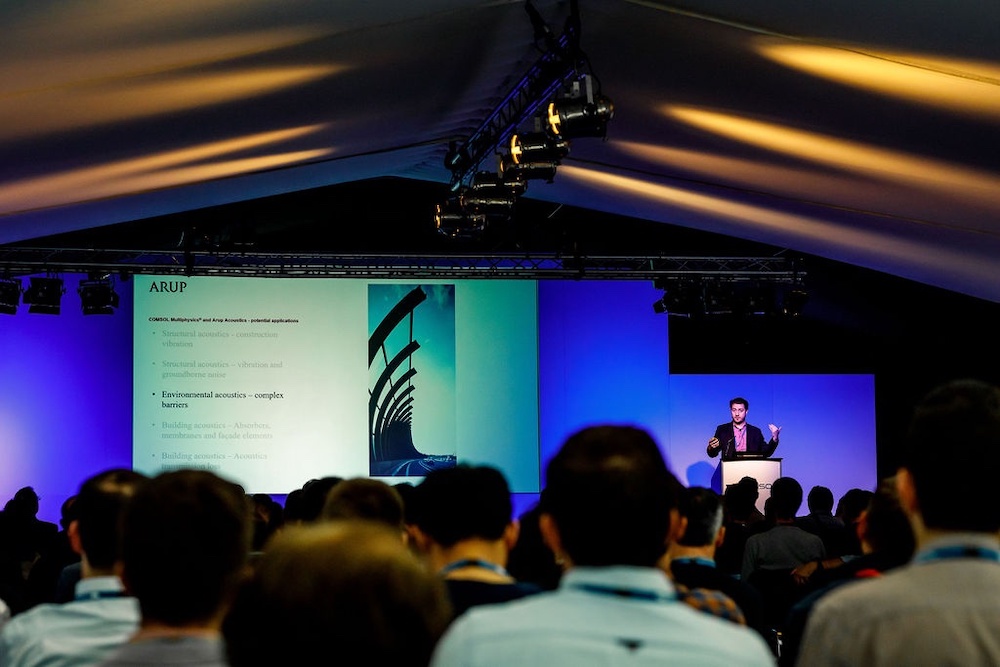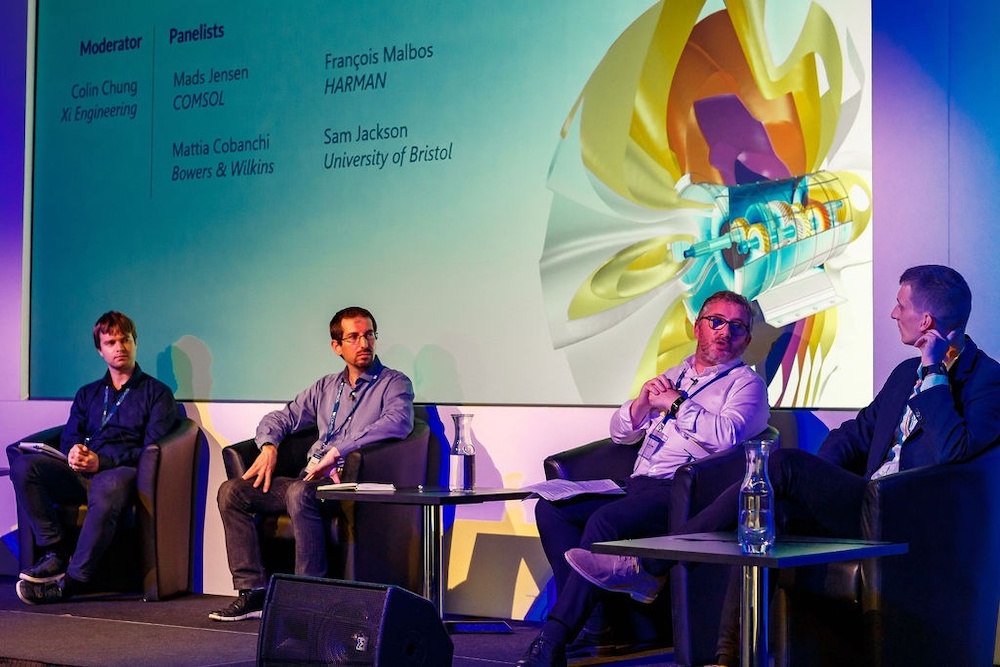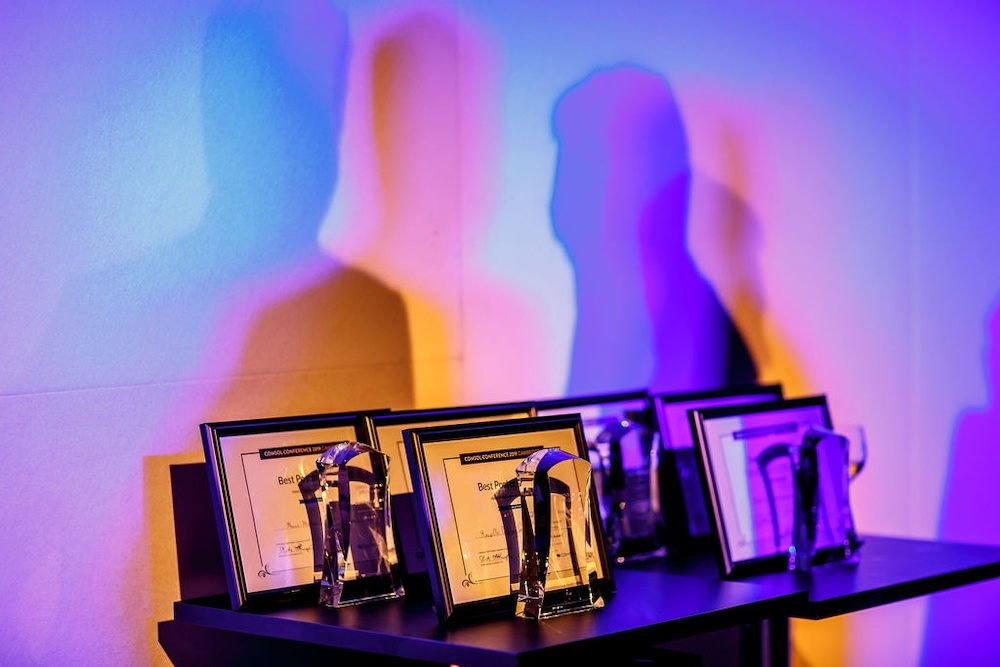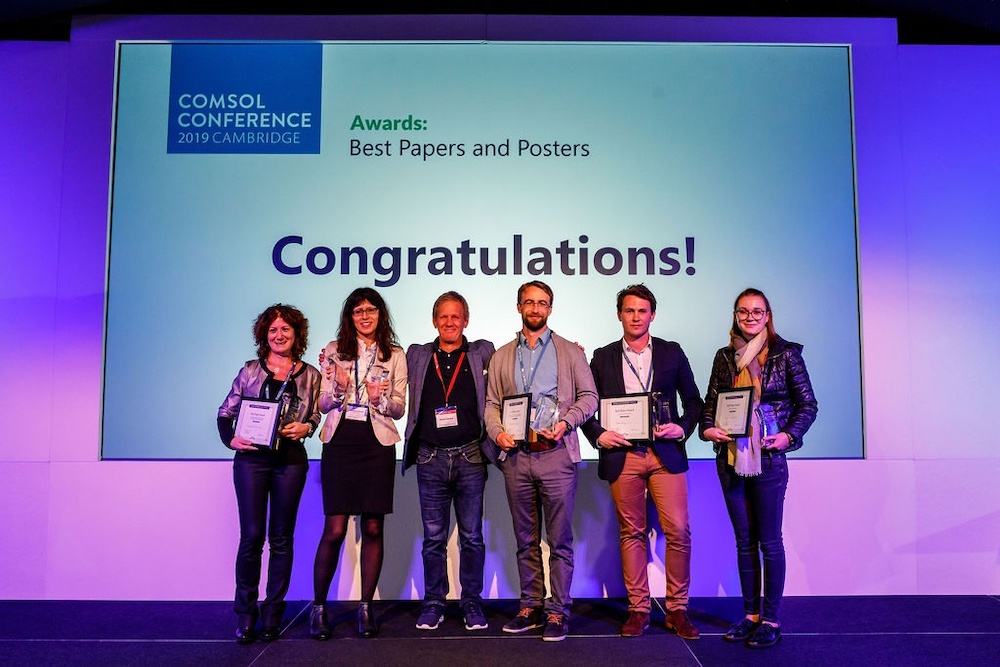
While the students of Churchill College at the University of Cambridge in England were away on holiday, a different type of learning took place. At the COMSOL Conference 2019 Cambridge, attendees learned about how today’s engineers, researchers, and specialists are using the COMSOL Multiphysics® software for innovative and exciting projects. Three notable aspects of the conference put multiphysics researchers and their accomplishments in the spotlight: the keynote talks, panel discussions, and awards ceremony…
Keynote Talks at the COMSOL Conference 2019 Cambridge
The COMSOL Conference 2019 Cambridge, held on September 24–26 in Cambridge, UK, featured four keynote talks from invited speakers.
First up, César Bustos of Arup gave four main reasons why his organization analyzes acoustics in the built environment using COMSOL Multiphysics: It enables them to solve complex problems, it is accurate, it gives them a better understanding of the problem, and it helps them perform innovative analysis. Bustos also gave a few interesting examples as part of his talk. For instance, his organization works with building acoustics designs, like absorbers and façade elements. The absorbers typically used in recording studios and similar areas are usually designed empirically via trial and error, but simulation enables his team to see the transmission losses earlier in the process.

A keynote talk from César Bustos of Arup. Photo by Lina + Tom.
Børge Noddeland of Rolls-Royce Electrical Norway AS discussed a topic that is on the minds of many: creating a sustainable electrical future. He discussed one of his organization’s projects, FlightPath 2050, which aims to design electrical systems in aircraft in a way that reduces CO2emissions per aviation passenger by 75%, keeping costs in mind as well. To do so, the team uses a combination of MATLAB® scripting and finite element analysis, including simulation of heat management, fluid flow, sensitivity analysis, and more.
Continuing the focus on renewable energy sources, Edmund Dickinson of National Physical Laboratory (NPL) talked about diagnosing the state of health (SoH) in aged batteries. State of health, or the nominal capacity of an aged versus brand new battery, is important for many battery applications. To analyze this metric, Dickinson ported a full electrical impedance spectroscopy (EIS) model into COMSOL Multiphysics as a rapid way to evaluate battery systems.
Lastly, Bojan Jokanović of SGL Carbon GmbH finished up the COMSOL Conference 2019 Cambridge keynotes with a discussion on the role of multiphysics modeling in manufacturing carbon-based products. There are many applications of carbon graphite and graphene today, and Jokanović uses simulation to optimize the graphitization process. Further, Jokanović builds simulation applications that are used by the organization’s technical sales staff that enable them to, for example, analyze silicon melting and thermal stress in induction-heated furnace designs.
Panel Discussions
Industry-led panel discussions are an exciting, and relatively new, aspect of the COMSOL Conference each year. In Cambridge, four panel sessions were held featuring panelists working in the industry as well as COMSOL Certified Consultants and staff members. The first panel, Advanced Materials & Additive Manufacturing, brought up many questions pertinent to this rapidly developing industry, including the benefits of additive manufacturing, defects you are likely to get during this process, and how porosity levels in materials affect the manufacturing process.

A scene from the Advances of Acoustic Simulations for Product Development panel discussion. Photo by Lina + Tom.
The moderator of the panel, Bill Clyne of Double Precision Consultancy, recommended an online learning resource for those interested in additive manufacturing calledDissemination of IT for the Promotion of Materials Science(DoITPoMS), available from the University of Cambridge.
The Powertrain Electrification panel discussion included panelists working across a wide range of industries, including applied technologies, manufacturing, and chemistry. The topics raised also varied widely, ranging from Formula 1 to trends in metal-alloy batteries. One notable idea that the panelists discussed was how simulation can be a proactive, not just iterative tool, helping engineers assess whether new technologies that are not even available yet can be used in the powertrain electrification field.
The next panel, Digital Twins & Industry 4.0, brought these buzzwords into the realm of simulation, modeling, and engineering. The benefits and possibilities of digital twins, IoT, and connected devices are already well known, but the panelists discussed the steps that need to be made to make the real-time analysis of digital twins a reality, as well as how simulation can help.
The Advances of Acoustic Simulations for Product Development panel emphasized how acoustics analyses call for the inclusion of multiphysics in order to bring acoustics designs to market. This sentiment applies not only to loudspeakers, microphones, mufflers, and other consumer products but also metamaterials and room and building acoustics, too.
Best Paper and Poster Awards
A barbecue on the Churchill College courtyard and award ceremony wrapped up the final evening of the COMSOL Conference 2019 Cambridge. Three awards each were given to the top papers and posters from the hundreds of impressive research projects submitted as part of the conference proceedings.

The Best Paper and Best Poster awards for the COMSOL Conference 2019 Cambridge. Photo by Lina + Tom.
First, Mickael Courtois accepted a Best Paper award for “A Method to Reduce Calculation Time in Multiphysics Modeling of Welding Processes. Application to Laser and GMAW Welding”, along with researchers Muriel Carin, Philippe Le Masson, Stephen Cadiou, and Sadok Gaied. The paper discusses the setup of a realistic multiphysics model of a welding process at the melt-pool scale.
Another Best Paper award went to “Design and optimization of circularly polarized antennas for mobile shooting of sport events” by Assunta De Vita along with A. Lucco Castello, B. Sacco. They used COMSOL Multiphysics to analyze a novel UHF antenna design that can be used for mobile shooting at popular sporting events, such as motorcycle races.
Best Poster awards were given to three particularly engaging and interesting poster presentation topics. “Numerical Simulation of Convective Mixing in Geologic Carbon Sequestration Applications” by Anna-Maria Eckel et al. and “SpaceX Hyperloop Competition: Fluid Damper Optimization Through CFD and Multi-Body Simulations of The Prototype Dynamic Response to Stochastic Excitation” by Jerome Harray et al. Both received Best Poster awards for their efforts.
One project took home both a Best Paper and Best Poster award! “Impact of Different Modeling Approaches in Field Focusing Predictions of Hyperthermia Cancer Therapy” by Rossella Gaffoglio along with G. Vecchi, M. Righero, G. Giordanengo, and M. Zucchi discusses the use of the COMSOL Multiphysics® software and LiveLink™forMATLAB® to reproduce a needle-based hyperthermia treatment for cancerous head and neck tumors.

The winners of the Best Paper and Poster awards. Photo by Lina + Tom.
One poster didn’t take home an official award, but received impromptu kudos from Svante Littmarck, CEO and founder of COMSOL. The poster, “Example of Educational Selected Projects with COMSOL® Class Kit at Department of Physics, University of Orleans” by Nadjib Semmar, discussed different exciting projects used to get students excited about learning simulation, such as investigating how many times you would need to slap a chicken in order to cook it. Projects like these are important for sparking interest in the next generation of engineers — and what better place to celebrate that than the education-rich city of Cambridge?
See You in 2020!
If you enjoyed this roundup of the exciting events taking place at the COMSOL Conference 2019 Cambridge, we hope to see you next year at the COMSOL Conference 2020 Grenoble in France!



Comments (0)